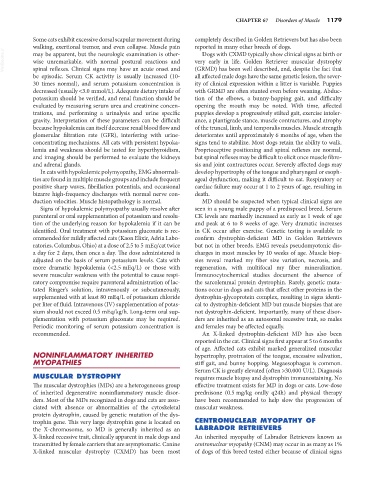Page 1207 - Small Animal Internal Medicine, 6th Edition
P. 1207
CHAPTER 67 Disorders of Muscle 1179
Some cats exhibit excessive dorsal scapular movement during completely described in Golden Retrievers but has also been
walking, exertional tremor, and even collapse. Muscle pain reported in many other breeds of dogs.
VetBooks.ir may be apparent, but the neurologic examination is other- very early in life. Golden Retriever muscular dystrophy
Dogs with CXMD typically show clinical signs at birth or
wise unremarkable, with normal postural reactions and
spinal reflexes. Clinical signs may have an acute onset and
all affected male dogs have the same genetic lesion, the sever-
be episodic. Serum CK activity is usually increased (10- (GRMD) has been well described, and, despite the fact that
30 times normal), and serum potassium concentration is ity of clinical expression within a litter is variable. Puppies
decreased (usually <3.0 mmol/L). Adequate dietary intake of with GRMD are often stunted even before weaning. Abduc-
potassium should be verified, and renal function should be tion of the elbows, a bunny-hopping gait, and difficulty
evaluated by measuring serum urea and creatinine concen- opening the mouth may be noted. With time, affected
trations, and performing a urinalysis and urine specific puppies develop a progressively stilted gait, exercise intoler-
gravity. Interpretation of these parameters can be difficult ance, a plantigrade stance, muscle contractures, and atrophy
because hypokalemia can itself decrease renal blood flow and of the truncal, limb, and temporalis muscles. Muscle strength
glomerular filtration rate (GFR), interfering with urine- deteriorates until approximately 6 months of age, when the
concentrating mechanisms. All cats with persistent hypoka- signs tend to stabilize. Most dogs retain the ability to walk.
lemia and weakness should be tested for hyperthyroidism, Proprioceptive positioning and spinal reflexes are normal,
and imaging should be performed to evaluate the kidneys but spinal reflexes may be difficult to elicit once muscle fibro-
and adrenal glands. sis and joint contractures occur. Severely affected dogs may
In cats with hypokalemic polymyopathy, EMG abnormali- develop hypertrophy of the tongue and pharyngeal or esoph-
ties are found in multiple muscle groups and include frequent ageal dysfunction, making it difficult to eat. Respiratory or
positive sharp waves, fibrillation potentials, and occasional cardiac failure may occur at 1 to 2 years of age, resulting in
bizarre high-frequency discharges with normal nerve con- death.
duction velocities. Muscle histopathology is normal. MD should be suspected when typical clinical signs are
Signs of hypokalemic polymyopathy usually resolve after seen in a young male puppy of a predisposed breed. Serum
parenteral or oral supplementation of potassium and resolu- CK levels are markedly increased as early as 1 week of age
tion of the underlying reason for hypokalemia if it can be and peak at 6 to 8 weeks of age. Very dramatic increases
identified. Oral treatment with potassium gluconate is rec- in CK occur after exercise. Genetic testing is available to
ommended for mildly affected cats (Kaon Elixir, Adria Labo- confirm dystrophin-deficient MD in Golden Retrievers
ratories, Columbus, Ohio) at a dose of 2.5 to 5 mEq/cat twice but not in other breeds. EMG reveals pseudomyotonic dis-
a day for 2 days, then once a day. The dose administered is charges in most muscles by 10 weeks of age. Muscle biop-
adjusted on the basis of serum potassium levels. Cats with sies reveal marked my fiber size variation, necrosis, and
more dramatic hypokalemia (<2.5 mEq/L) or those with regeneration, with multifocal my fiber mineralization.
severe muscular weakness with the potential to cause respi- Immunocytochemical studies document the absence of
ratory compromise require parenteral administration of lac- the sarcolemmal protein dystrophin. Rarely, genetic muta-
tated Ringer’s solution, intravenously or subcutaneously, tions occur in dogs and cats that affect other proteins in the
supplemented with at least 80 mEq/L of potassium chloride dystrophin-glycoprotein complex, resulting in signs identi-
per liter of fluid. Intravenous (IV) supplementation of potas- cal to dystrophin-deficient MD but muscle biopsies that are
sium should not exceed 0.5 mEq/kg/h. Long-term oral sup- not dystrophin-deficient. Importantly, many of these disor-
plementation with potassium gluconate may be required. ders are inherited as an autosomal recessive trait, so males
Periodic monitoring of serum potassium concentration is and females may be affected equally.
recommended. An X-linked dystrophin-deficient MD has also been
reported in the cat. Clinical signs first appear at 5 to 6 months
of age. Affected cats exhibit marked generalized muscular
NONINFLAMMATORY INHERITED hypertrophy, protrusion of the tongue, excessive salivation,
MYOPATHIES stiff gait, and bunny hopping. Megaesophagus is common.
Serum CK is greatly elevated (often >30,000 U/L). Diagnosis
MUSCULAR DYSTROPHY requires muscle biopsy and dystrophin immunostaining. No
The muscular dystrophies (MDs) are a heterogeneous group effective treatment exists for MD in dogs or cats. Low-dose
of inherited degenerative noninflammatory muscle disor- prednisone (0.5 mg/kg orally q24h) and physical therapy
ders. Most of the MDs recognized in dogs and cats are asso- have been recommended to help slow the progression of
ciated with absence or abnormalities of the cytoskeletal muscular weakness.
protein dystrophin, caused by genetic mutation of the dys-
trophin gene. This very large dystrophin gene is located on CENTRONUCLEAR MYOPATHY OF
the X-chromosome, so MD is generally inherited as an LABRADOR RETRIEVERS
X-linked recessive trait, clinically apparent in male dogs and An inherited myopathy of Labrador Retrievers known as
transmitted by female carriers that are asymptomatic. Canine centronuclear myopathy (CNM) may occur in as many as 1%
X-linked muscular dystrophy (CXMD) has been most of dogs of this breed tested either because of clinical signs

